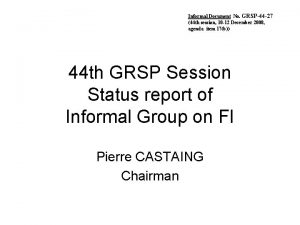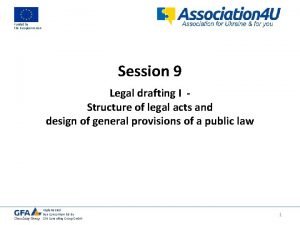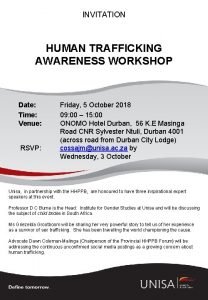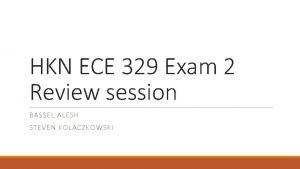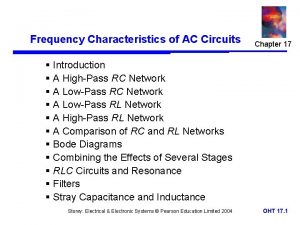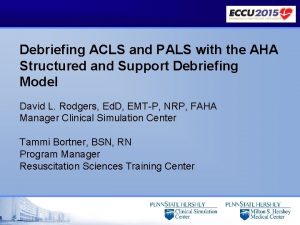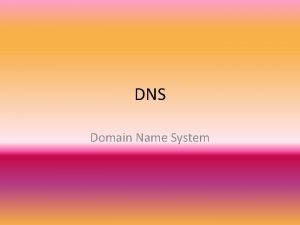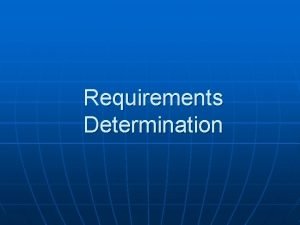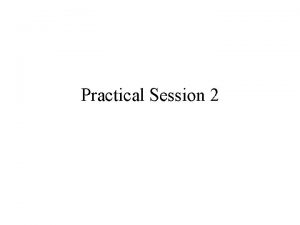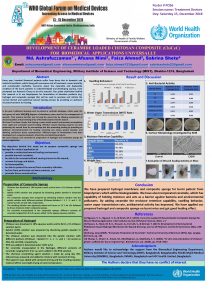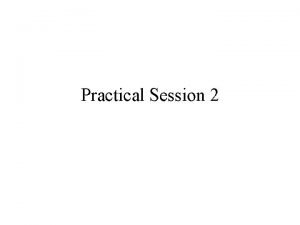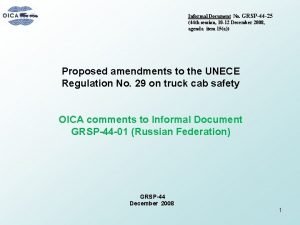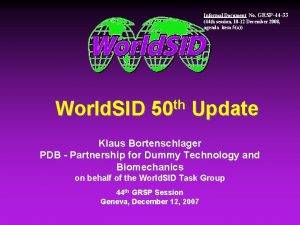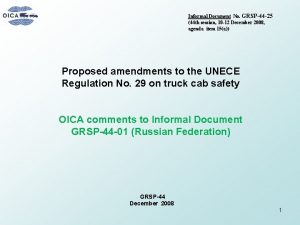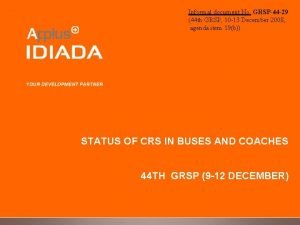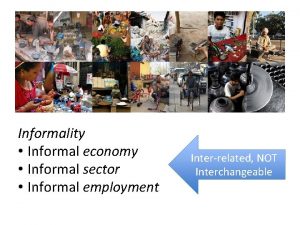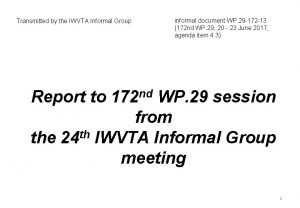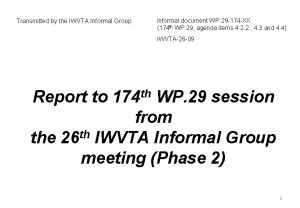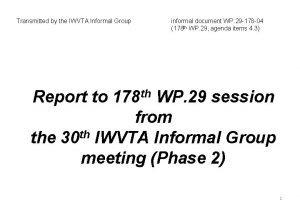Informal Document No GRSP44 27 44 th session
















- Slides: 16

Informal Document No. GRSP-44 -27 (44 th session, 10 -12 December 2008, agenda item 17(b)) 44 th GRSP Session Status report of Informal Group on FI Pierre CASTAING Chairman

Mandate - GRSP and WP 29 decisions • December 2007 - GRSP Report - ECE/TRANS/WP. 29/GRSP/42 § 47. – – • France suggested the establishment of a new informal group. GRSP welcome the initiative of France to set up a new informal group on child restraint systems. GRSP agreed to seek mandate from WP 29. GRSP agreed to defer the full consideration of ECE/TRANS/WP. 29/GRSP/2007/17 to the informal group. March 2008 - WP 29 Report - ECE/TRANS/WP. 29/1066 § 20. – • WP. 29 gave its consent to set up the new informal group to amend Regulation N° 94 (Frontal impact) by changing the type of deformable barrier element and revising testing procedure. May 2008 - GRSP Report - ECE/TRANS/WP. 29/GRSP/43 § 43. – – – The draft terms of reference were agreed by the informal working group at its first meeting. GRSP adopted the terms of reference, as reproduced in Annex VII to this report. The expert from the United States of America stated the intention of her country to continue to collaborate with France sharing real-world data and outcome research. The next meeting would be held the 6 th October 2008 A draft proposal of amendment to the Regulation should be finalized by 2010.

Terms of Reference - Approved To. R 1. The informal group shall consider the updating of the current R 94 regulation for adapting it with the new context and new vehicle generation and include regulatory impact assessment. • • 2. 3. 4. 5. 6. Proper justification for all proposed changes (speed, offset, PDB, etc. ) shall be provided and assessed by the informal group. In addition a cost benefit study shall be made. The group shall focus on self-protection but take into account research worldwide on compatibility in order not to go against future compatibility requirements. The informal group will take into consideration amongst others the technical expertise of EEVC WG 16 and EEVC WG 15, as well as the results of the discussions held in the informal group and at GRSP. The discussion will be based on the formal documents n° ECE/TRANS/WP. 29/GRSP/2007/17 presented to GRSP in December 2007. If necessary, the informal group could propose complementary test methods. The target completion date for the informal group shall be the forty -seven session of GRSP (May 2010).

Meetings 1. 19 th May 2008 – UNECE – GENEVA 2. 6 th October 2008 – OICA – PARIS 3. 9 th December 2008 – UNECE – GENEVA 4. 10 th March – OICA – PARIS

List of issues • Self Protection Issues • Compatibility Issues (in terms of PDB characteristics)

List of issues - Priority 1 Self Protection Issues 1. Is an accident analysis needed to update information on changing vehicle fleet? 2. Identify critical injury mechanisms (in particular relevance of thorax injuries in high deceleration pulse type accidents) 3. Assess potential for harmonisation for frontal impact procedures. 4. Finalise the test severity for regulation test – determine acceptable minimum values for vehicles. 5. Validate the PDB EES calculation method 6. Validate that the PDB test guarantees a minimum EES test severity for all vehicles. 7. Validate that PDB provides the required test requirements for interior restraints

List of issues – Priority 2 Compatibility Issues (in terms of PDB characteristics) 1. Investigate the vehicle force deflection characteristics that may be generated in future vehicle designs which are based on the PDB test approach. 2. Identify the potential use of the PDB to evaluate geometric characteristics of vehicles to encourage compatibility. 3. Determine reproducibility and repeatability of measuring honeycomb barriers in crash tests 4. Confirm vehicle structures are objectively measured in PDB. In particular the barrier deformations due to vehicle rotation around the barrier should not affect the compatibility assessment procedures.

Present status The seven issues with Priority 1 are in ongoing discussion 1. Accident analysis 2. Critical injury mechanisms 3. Potential for harmonisation 4. Test severity for regulation test 5. PDB EES calculation method 6. Minimum EES test severity 7. Requirements for interior restraints Input from all members on these issues will be collected and pros and cons analysed until March 2009

Accident analysis Presentations of data from different countries: • • France Japan Sweden Germany A cost benefit and an impact assessment are still needed before going further.

Critical injury mechanisms Input from different countries on thorax injury level with newer vehicle models. • APROSYS European program • French data • Swedish data • German data

Potential for harmonisation • Clear demand from Japan to harmonise Frontal Impact procedures between signatories of 1958 agreement. • USA is looking on the output of the group.

Test severity for regulation test • Presentation by The Netherlands of an alternative method for frontal impact: – Mobile Barrier using the PDB deformable element • Presentation of PDB pulses by France

PDB EES calculation method • Algorithm • YEAR 2007: PDB SOFT 2

Minimum EES test severity ? • Japanese program on comparison of PDB test with regulation and JNCAP tests. • Input from French study • Study of PDB with Mobile Progressive Deformable Barrier and Mobile Rigid Barrier Tests – MPDB and MRB

Requirements for interior restraints • Some group members think that inclusion of an additional “full width test” in the procedure may address the concerns raised. • Triggering of restraint systems is not properly addressed by the current R 94 test procedure and could be improved by other test procedure(s)

Conclusion • There are some concerns inside the group concerning the possible exploitation of the change of the barrier in a direction that it is not wanted. • The group needs some more time and discussions before a possible common position. • The group agrees that we reached today a good level of self protection in current cars. • Extending the scope of current ECE R 94 to heavier vehicles above 2. 5 tons may be contra productive for road safety.
 Document cookie set
Document cookie set Informal document
Informal document Registro formal e informal
Registro formal e informal Welcome to the new session
Welcome to the new session Fordham university rose hill campus map
Fordham university rose hill campus map Microsoft technology centre
Microsoft technology centre Brenda andrews oklahoma
Brenda andrews oklahoma Session 9 explained
Session 9 explained Awareness session invitation
Awareness session invitation Hkn review session
Hkn review session Solved: ph dincussion ac circuits session 12 q2. low-pass
Solved: ph dincussion ac circuits session 12 q2. low-pass Gas debriefing
Gas debriefing Domain name system nedir
Domain name system nedir Requirement determination example
Requirement determination example Multipicand
Multipicand 6 session name
6 session name Practical session meaning
Practical session meaning

